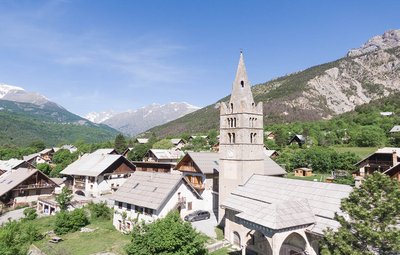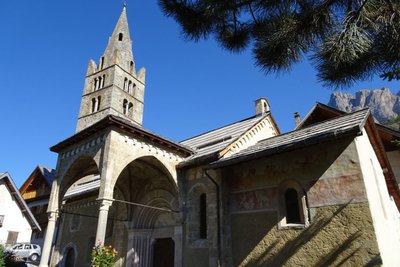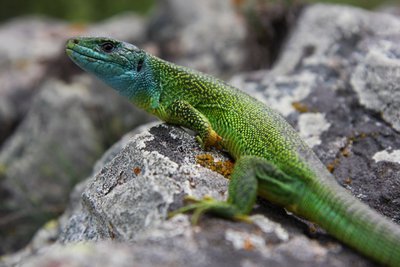
Tour of the Pays des Ecrins in 3 days
This 3-day trek allows time to take in the landscape, be it natural or built. It tells the unique and iconic story of this major gateway to Les Écrins and its many resources.
3 steps
Description
The starting point of the trek, Vallouise, is a small tourist town featuring traditional architecture. Here, you can visit the Park Centre (“Maison du Parc”), explore the gardens and alleyways and make your final purchases before setting off on your tour.Following a forest track, the first stage takes you to Puy-Saint-Vincent, a mountain village and ski resort. Then, passing through a number of hamlets of this community, you come to the Col de la Pousterle and its vast grassy stretches surrounded by larches. Here, you gain a remarkable panoramic view over Pelvoux and the Glacier Blanc. As you head down towards the Durance, the forest ambience that predominates for most of the descent gives way to more urban surroundings: L’Argentière la Bessée, a small town with a rich industrial past, has not only preserved its economic and social dynamism but also offers an attractive living environment and lifestyle!The second stage leads to the charming mountain pasture hamlet of Bouchier. After following the Gyronde mountain stream and passing through the village of Les Vigneaux, you climb uphill towards this hamlet enjoying superb views over the Queyras valley and the Briançon area. This slope faces due south and it can be very hot here despite the forest cover.During your overnight stay in Bouchier, make the most of the pure skies and the absence of light pollution to gaze at the stars, either directly or from the astronomical observatory established there, if it is open.The final stage takes you back to Vallouise. The balcony pathway above the Gyronde hugs the Montbrison massif and its famous ridge formations ("Dentelles", meaning lace in French). After Les Vigneaux, the view opens up onto the glacial valleys of Ailefroide and the Glacier Blanc, and also onto your first-stage route, Puy-Saint-Vincent and the Col de la Pousterle.
- Departure : Vallouise
- Arrival : Vallouise
- Towns crossed : L'Argentière-la-Bessée, Les Vigneaux, Saint-Martin-de-Queyrières, Vallouise-Pelvoux, and Puy-Saint-Vincent
Altimetric profile
Recommandations
 In mountain pastures, protection dogs are there to protect the herds from predators (wolves, etc.).
In mountain pastures, protection dogs are there to protect the herds from predators (wolves, etc.).
When I hike I adapt my behavior by going around the herd and pausing for the dog to identify me.
Find out more about the actions to adopt with the article "Protection dogs: a context and actions to adopt".
Tell us about your meeting by answering this survey.
Information desks
23 Avenue de la République, 05120 L'Argentière-La Bessée
Place de l'Eglise, 05340 Vallouise
Vallouise Park house
, 05290 Vallouise
Information, documentation, models, exhibitions, screenings, product sales and works of the Park. Guided tours for school, reservation required. The new Park House opened in Vallouise since June 1, and offers visitors an interactive permanent exhibition inviting to explore the area and its heritage. A temporary exhibition space will allow a renewed offer. Finally, the device is completed by an audiovisual room to organize screenings and conferences Free admission. All animations of the Park are free unless otherwise stated.
Transport
Informations : paysdesecrins.com/transports
Access and parking
9 kms away from L'Argentière La Bessée by road D994E
Parking :
Sensitive areas
Short-toed snake eagle
- Impacted practices:
- Aerial,
- Sensitivity periods:
- MarAprMayJunJulAugSep
- Contact:
- Parc National des Écrins
Julien Charron
julien.charron@ecrins-parcnational.fr
Peregrine falcon
- Impacted practices:
- Aerial, Vertical
- Sensitivity periods:
- FebMarAprMayJun
- Contact:
- Parc National des Écrins
Julien Charron
julien.charron@ecrins-parcnational.fr
Short-toed snake eagle
- Impacted practices:
- Aerial,
- Sensitivity periods:
- MarAprMayJunJulAugSep
- Contact:
- Parc National des Écrins
Julien Charron
julien.charron@ecrins-parcnational.fr
23 points of interest

Eglise des Vigneaux - Blandine Reynaud - PDE  History
HistoryThe village of Les Vigneaux
In spite of the altitude, the region's dry climate and the local growing conditions of limestone and sediments facing due south made the planting of grapevines possible as far back as the tenth century. The municipality owes its name to the presence of these vineyard operations, which were very significant in the late nineteenth century. The almost simultaneous appearance of the phylloxera aphid and the Briançon train, bringing wine from Provence, spelled the end of this activity here.

L'église des Vigneaux - Office de tourisme Pays des Écrins  Vernacular heritage
Vernacular heritageThe church in Les Vigneaux
The church of Saint-Laurent with its elegant porch dates from the fifteenth and sixteenth centuries. On its south wall there are frescoes depicting the vices, dragged towards hell by a demon, and their punishments. Enough to make you shudder! Its Lombard Romanesque bell tower has a very rare one-handed clock dating from the eighteenth century. It is one of the oldest working clocks of its type.

Cadran solaire de l'église des Vigneaux - Office de tourisme Pays des Écrins  Vernacular heritage
Vernacular heritageThe sundial
The sundial is an eighteenth-century tradition widespread across the Southern Alps where the sun is ever-present. Artisan sundial makers produced these sundials, which were added as a decoration to house fronts, religious buildings or, as here, a tower. The sayings inscribed on them make some of these artistic works philosophical as well as decorative.

Damien Combrisson - Parc national des Écrins  Fauna
FaunaThe western green lizard
Very shy, this large lizard quickly takes refuge beneath a bush or stone, or among the tangled branches of a hedge when it senses danger. It is on average 30 cm in length and it is bright green slightly speckled with black. During the mating season, the male presents a bright blue colouring on his throat and on the sides of his head. It lives on sunny south-facing slopes, in uncultivated areas and forest edges, where it feeds primarily on insects.

Le circaète Jean-le-Blanc - Marc Corail - Parc national des Écrins  Fauna
FaunaThe short-toed snake eagle
In March, this large brown bird of prey, brown on its upperside, white speckled with black on its underside and a dark head, returns from Sub-Saharan Africa where it has spent the winter. It feeds primarily on reptiles which its hunts in steppe or barren areas, derelict sites or stony terrain. It builds its nest in a pine tree where it will rear a single chick. It can often be seen hovering in the air, thirty or so metres above the ground, and then swooping down on its prey.

La chapelle Saint-Hippolyte de Bouchier - Office de tourisme Pays des Écrins  History
HistoryThe hamlet of Bouchier
Bouchier is a small hamlet in the municipality of Saint-Martin-de-Queyrières, which has a few permanent inhabitants in spite of its relatively inaccessible location. Standing a little apart from the hamlet, on a promontory overlooking the Durance valley, the chapel of Saint-Hippolyte dates from the early sixteenth century. It was built against what used to be a hermit's cell, and contains frescoes some of which relate the miraculous cures performed by the saint. It drew ailing people who flocked here to seek his intercession.

Aigle royal - Pascal Saulay - Parc national des Écrins  Fauna
FaunaThe eagles of the Tête d'Aval
Eagles can be seen gliding around the Tête d'Aval. In the hottest part of the day, they circle on the thermals rising above the limestone cliffs. Having gained height in this way, they can reach their hunting territory without having to flap their wings.

Le chévrefeuille d'Étrurie - Bernard Nicollet - Parc national des Écrins  Flora
FloraEtruscan honeysuckle
Etruria was the territory of the Etruscans, in the area of present-day Tuscany. Although this honeysuckle does not grow only in Tuscany, it is Mediterranean, however, and only grows naturally in the wild in the southern half of France. Being a plant that needs warmth, it does not grow at altitude, except here where the south-facing slopes are particularly dry and warm. Its large pink and yellow flowers are highly perfumed.
Aiguilles de pin sylvestre - Parc national des Écrins  Flora
FloraOn the south-facing slope, pine forest
The track passes through a forest of Scots pines, mixed with some downy oak trees. It is a forest typical of those found in the lower south-facing slopes (those exposed to the sun) in the intra-alpine valleys.
Le torcol - Damien Combrisson - Parc national des Écrins  Fauna
FaunaThe northern wryneck
In the spring, an odd song can be heard among the old trees in the orchard, a loud song similar to that of the green woodpecker, only slower. It is that of the northern wryneck. This bird owes its name to the extreme way it extends and twists its neck when it feels threatened. Its French name torcol fourmilier is a reference to the fact that it feeds on ants (fourmils in French). Difficult to spot because its plumage merges into the colour of the tree trunks, it gives its presence away by its song when it returns from its migration.
Aiguilles de pin sylvestre - Christian Baïsset - Parc national des Écrins  Flora
FloraThe Scots pine
A long trunk that is reddish-brown towards the top, sparse foliage, grey-green needles grouped in pairs... It has to be the Scots pine. Happy in poor soil, this softwood tree can withstand below-zero temperatures as well as summer droughts, and so it is very common in intra-alpine valleys with a continental climate, like the Vallouise.

La limodore à feuilles avortées (limodorum abortivum) - Mireille Coulon - Parc national des Écrins  Flora
FloraThe violet bird's-nest orchid
In the pine forest undergrowth stands a large, completely purple orchid. It has no leaves, just a few whitish scales on the stem. Lacking chlorophyll (the green plant pigment which plays a role in photosynthesis, the process that allows the production of organic matter), it lives as a parasite on tree roots.

Pic nir et ses petits au nid - Robert Chevalier - Parc national des Écrins  Fauna
FaunaThe black woodpecker
Sporting a black cap, the black woodpecker is the biggest of the woodpecker family. Wary and solitary, it is difficult to spot, but its strident calls give its presence away. It feeds mainly on ants and insects living in dead trees, which it extracts by hammering into the wood. It hollows out a nest hole in trees. Once the young have left the nest, it may be taken over by owls or forest-dwelling bats.

Place de l'Église - Thibaut Blais  History
HistoryThe church in Vallouise
The church of Saint-Étienne dates from the fifteenth and sixteenth centuries. Inside is an altarpiece and a tabernacle in gilded wood dating from the eighteenth century, together with come mural paintings. Not far from the church stands the late sixteenth-century Chapel of the Penitents with a nineteenth-century painted facade.

Petit rhinolophe enveloppé dans ses ailes - Mireille Coulon - Parc national des Écrins  Fauna
FaunaThe lesser horseshoe bat
In summer, bats take up residence in the church roof. The species living here is the lesser horseshoe bat, which has been in serious decline over recent decades. Every year, the mothers return after hibernating in caves and each one gives birth to one bat pup. Bats are insectivore mammals threatened by the insecticides used on farmland and on wooden structures and the loss of their hunting habitats and roosts, among other things. They are all protected.

Rue de Champ de Ville - Pierre Nossereau  Architecture
ArchitectureVallouise
Multi-storey houses - typical of the architecture in the valley in the seventeenth and eighteenth centuries - stand on the old village street. The ground floor was reserved for animals, the first floor for habitation and the upper floors for grain storage. People moved from one floor to another by means of balconies interconnected by a staircase. Many of these balconies are arcaded with stone columns. This type of arcaded balcony is found throughout the valley.

Torcol fourmilier - Damien Combrisson - Parc national des Écrins  Fauna
FaunaThe northern wryneck
The old trees in the orchard are home to the northern wryneck. It has a loud song, rather like that of the green woodpecker, only slower. This bird owes its name to the extreme way it extends and twists its neck when it feels threatened. Its French name torcol fourmilier is a reference to the fact that it feeds on ants (fourmils in French). Difficult to spot because its plumage merges into the colour of the tree trunks, it gives its presence away by its song when it returns from its migration.

Petite verge d'or - Cédric Dentan - Parc national des Écrins  Flora
FloraThe great goldenrod
In damp spots on the edge of the track, swathes of tall plants grow. It forms great plumes of tiny yellow plants. The great goldenrod, still known as the tête d'or or "head of gold" is a plant native to North America and introduced into Europe in the eighteenth century as an ornamental. Since then, it has colonised a large are of Europe and in some places it even competes with the local flora.

Le semi-apollon - Mireille Coulon - Parc national des Écrins  Fauna
FaunaThe clouded Apollo
This butterfly with hyaline (glass-like) translucent white wings, marked with two black spots, flutters around the clearing or the edges of the forest, where the host plants of its caterpillars grow: the corydalis. Although abundant locally, it is nevertheless a species in sharp decline and is protected.

Vue sur Puy Saint Vincent - Christophe Albert - Parc national des Écrins  History
HistoryThe Sentier du Facteur - the postman's path
In former times, the postman would take this path every day: He would set out from Vallouise, deliver letters in Puy-Saint-Vincent and drop back down to Vallouise, stopping at the hamlets of Parcher on the way. In the winter, when the snow was too deep, the Traversouires (the inhabitants of Puy-Saint-Vincent) donned their snowshoes and wielded their shovels to clear the postman's path down to Vallouise.

Chauve-souris en vol en contre jour - Mireille Coulon - Parc national des Écrins  Fauna
FaunaForest-dwelling bats
Bats don't just live in caves! In summer, some forest-dwelling species shelter in old hollow trees or woodpecker holes during the day. Sometimes, the females also form little colonies here, where their young will be born (one bat pup per female). In this forest, which is still young with very few old trees, artificial roosts have been installed to help the bats and to facilitate their study.
La chouette chevêchette - Christophe Albert - Parc national des Écrins  Fauna
FaunaThe pygmy owl
The call of this small, nocturnal bird of prey can be heard in the spring, and also in the autumn when it can utter some peculiar sounds. Active during daytime hours and at dusk, the pygmy owl is a predator of passerine birds and small forest rodents. But when they spot it, passerines will come together in large numbers to mob it, so as to prevent any attempted surprise attack. It is restricted to mountain forests where it seeks out trees with woodpecker cavities where it builds its nest.

Epilobe en épis - Thierry Maillet - Parc national des Écrins  Flora
FloraThe rosebay willowherb
The forest tracks are edged with great swathes of a tall plant which has purple flowers arranged in loose spikes. The rosebay willowherb is a pioneer plant and favours road embankments and disturbed ground. In late summer, its very numerous seeds, each with a little plume, float away en masse glowing in the advancing twilight…
Source

Report a problem or an error
If you have found an error on this page or if you have noticed any problems during your hike, please report them to us here:






